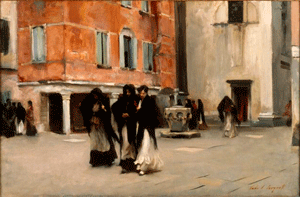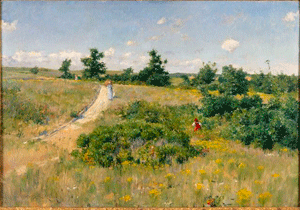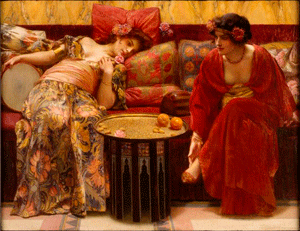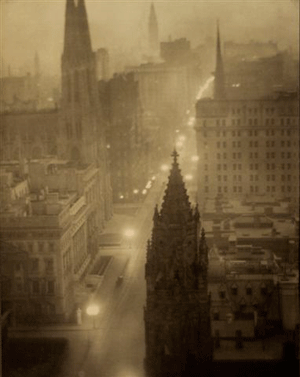
Childe Hassam…Clearing Sunset (Corner of Berkeley Street and…Columbus Avenue) 1890, Oil on canvas…25 x 30 ½ in.
A century ago, American artists
looked to France for instruction and inspiration. The brilliant colors and
fractured brushwork of Impressionism charted a new, more modern and urbane course for the artists showcased in An
Impressionist Sensibility: The Halff Collection at the McNay Art Museum.
San Antonians Hugh and Marie Halff
assembled these 26 paintings from 1986 to 1989, forming what is considered the
best collection of American impressionists still in private hands, including
works by William Merritt Chase, Childe Hassam, John Singer Sargent and John
Twachtman.
The paintings look dazzling in the
natural light of the McNay’s new Stieren wing, and the Halff collection is
accompanied by a companion show, TruthBeauty: Pictorialism and the Photograph
as Art, 1845-1945,
drawn from the collections at the George Eastman House. Also on view are Impressionist Graphics from the McNay’s print and drawing collection.
As part of its grand re-opening
following a $298 million renovation in 2006, the Smithsonian American Art
Museum showcased the Halff Collection, the catalog for which
includes an essay by the chief curator, Eleanor Jones Harvey. As she explains,
the Halffs started as contemporary art collectors, but switched to the late 19th
and early 20th-century after Marie hung a calendar of American
impressionism over Hugh’s bathroom scales.

John Singer Sargent…Sortie de l’eglise, Campo San Canciano, Venice…1880-82, Oil on canvas, 22 x 33 ½ in.
While many of the paintings are
light and colorful, three of the best have a dark, Velazquez-like moodiness. In
the case of Chase, the artist was directly influenced by an iconic Velazquez
work. He painted Ring Toss, featuring three of his young daughters playing the game in his
studio, after a trip to Spain where he made a copy of Velazquez’s Las
Meninas. The rich brown tones of the floor’s wood grain are contrasted with the murky
black shadows of the background, almost forming a stage, with the girls
pitching toward the viewer.
Sargent
evokes Velazquez with his image of three women emerging from a church. Sortie
de l’eglise, Campo San Canciano, Venice, dramatically blends midnight blacks,
vivid touches of reds and stone-washed whites. Sargent’s The Sulphur Match is
also dark and romantic, featuring the almost obscured face of a man bending to
light a match while a woman in a white dress and red shawl leans back in a
chair, two lovers lounging in a bar.
Chase, however, is primarily known
as a landscape painter. His Shinnecock Landscape with Figures is a more
characteristically sunny work. The scene is from Long Island, where Chase
taught his famous summer classes. His students included the likes of Rockwell
Kent, Charles Hawthorne and Julian Onderdonk,
the Texas impressionist known as the father of bluebonnet painting. Chase’s
idyllic sun-filled day, his wife and daughters walking amid the wildflowers,
reveals how much he influenced Onderdonk’s Hill Country landscapes. It also
reflects the artist who influenced most of the artists in this exhibit, James
McNeill Whistler.
Whistler’s motto of “art for art’s sake” pushed these American painters to take
the first steps toward modernism.
All of these artists studied in
France, the home of impressionism. Childe Hassam
spent four years in Paris from 1886 to 1889, studying at the Acadiemie Julian,
and then returned to Boston to paint urban scenes such as Clearing Sunset
(Corner of Berkeley Street and Columbus Avenue), with black hansom cabs
speeding over the rain-slicked cobble streets of Boston and steam rising from
passing trains. Hassam captured the hustle and bustle of a city in transition
from the 19th to 20th century. In a much brighter urban
scene from 1917, The New York Bouquet: West Forty-Second Street, flags of
several countries wave while a newly built 29-story skyscraper glows in the
crystalline sunlight.
Theodore Robinson’s
ragged brushstrokes evoke a blustery New York cold spell in Union Square,
Winter. He and Hassam were among several artists who took advantage of cheap
rents in apartments near the square. Another New York winter scene is Ernest
Lawson‘s The Flatiron Building, with its distinctive jutting, prow-like visage seen
through snow-laden tree branches.
Two of the most interesting
landscapes are by Twachtman,
who painted the river views from the porch of the Holley House in Cos Cob,
Connecticut,
during the winter and spring. Fog hangs heavy over a snow-shrouded landscape in Bridge in Winter, with only a few straggly wisps of bare tree branches. But
spring is clearly underway in From the Holley House, with blue water running
in the river and leaves beginning to sprout from the tree branches.
Images of women reflect the
turn-of-the-20th-century fascination with Japan, or “japonisme,”
and the Middle and Far East, or “orientalism.” A woman wears a kimono in Charles Sprague Pearce’s Lady with a Fan, while the subjects of Harry Siddons Mowbray’s Two Women lounge like fantasies of a Near Eastern harem. Edmund Tarbell
painted an American woman sitting on the floor, Japanese-style, while she cuts
out kirigami patterns. Whistler began incorporating Japanesque elements into
his work during the early 1860s, probably inspired by an exhibit of ukiyo-e
prints by Hokusai at the London Exhibition of 1862.
William McGregor Paxton’s Vermeer-influenced portrait of a woman reading a newspaper is one of the most
contemporary-looking paintings. But other female portraits reflect the
influence of the romantic, soft-focus photography of the era known as
pictorialism. In Robert Reid’s Woman on a Porch with Flowers, the woman’s dress seems to merge with the cut
flowers and wildflowers in the scene. Frank Weston Benson’s Elisabeth and
Anna, two women talking on a sunny shore, is startlingly similar to Alice M.
Boughton’s
photograph of Two Women Under a Tree in the TruthBeauty exhibit.
Photography both freed artists from
having to reproduce reality and reduced the need for painted portraits. But the
early photographers in TruthBeauty wanted to elevate the new medium of
scientific documentation to an art form, and so adopted a soft-focus approach
using dramatic lighting effects that seem to be derived from romanticism. And
it’s easy to find photographic examples that mimic the work of the American
impressionist painters, such as Edward Steichen’s Flatiron-Evening,
Alvin Langdon Coburn’s foggy Fifth Avenue from the St. Regis or John B.
Eaton’s Wet Day in Melbourne.
The Impressionist Graphics
exhibit includes works by artists not included in the Halff collection, such as
Mary Cassatt’s Peasant Mother and Child and J.M.W. Turner’s The Thames, along with artists
in the collection, such as Hassam’s The Lilies and Maurice Prendergast’s Venice.
These three exhibits reflect the
issues that American artists faced a century ago, breaking free of European
traditions, incorporating the new-found techniques of impressionism into an
American aesthetic and exploring new, more personal means of expression as
advancing technology eliminated the need for artists to paint realistically.
Halff Collection
TruthBeauty: Pictorialism and the
Photograph as Art, 1845-1945
Impressionist Graphics at the McNay
McNay Art Museum
February 3 through May 9, 2010
![]()
Dan R. Goddard is a writer living in San Antonio.
Also by Dan R. Goddard:
Vincent Valdez at the Southwest School of Art & Craft
Contemporary Ceramics at Blue Star
“Reclaimed: Paintings from the Collection of Jacques Goudstikker” at the
McNay
Tom Slick: International Art Collector
“Lonely Are the Brave” at Blue Star
San Antonio’s Museum Reach
Jonathan Monk at Artpace






